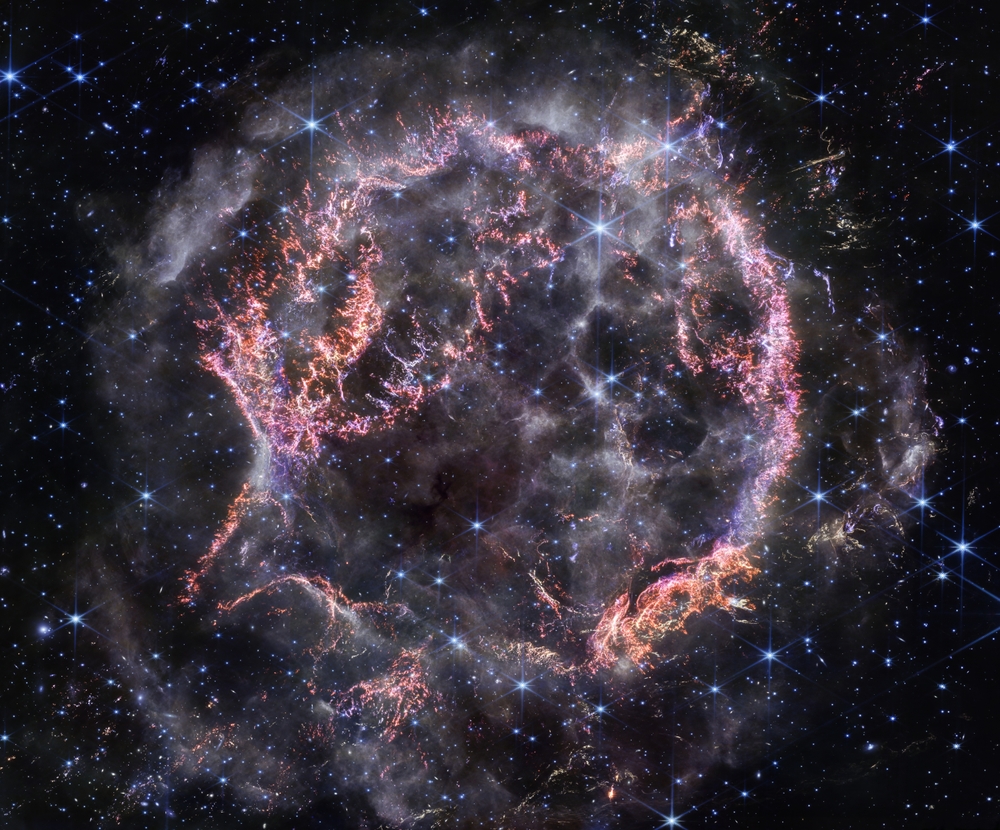
Snapshots of colorful galaxies and planets show that the beauty of our universe knows no bounds, and recent images of glowing space gas and dust captured by NASA are no exception. The James Webb Space Telescope (JWST) has caught yet another visual spectacle, depicting layers of interstellar material illuminated by a supernova in a phenomenon known as a thermal light echo.
Getting a glimpse of the brilliant scene through JWST, a team at NASA created a 3D scan of the interstellar material that displays its intricacies in tremendous detail. Now, astronomers are able to zoom into a piece of the universe that has never been seen before.
How the Glow Began
The force that caused the gas and dust to glow was actually set in motion long ago. It all started with the explosion of a huge star somewhere in the universe. The shockwave produced by the star’s collapse shot a burst of X-rays and ultraviolet light out into space.
The light then spent 350 years traveling through the universe and eventually reached the interstellar material observed by JWST; the gas and dust was subsequently warmed, causing it to glow in an infrared light. This result is called a thermal light echo.
JWST detected the light echo in the vicinity of Cassiopeia A, a supernova remnant in the constellation Cassiopeia, around 11,000 light-years from Earth. The interstellar material was observed three separate times by the telescope’s Near-Infrared Camera (NIRCam), showing the remarkable expansion of the light echo over the course of three weeks.
The recently observed glowing material, not related to the star that turned into Cassiopeia A, exists among dozens of other nearby light echoes that had first been observed by NASA’s Spitzer Space Telescope, which is now retired.
Read More: How the James Webb Space Telescope Takes Such Stunning Pictures
A Structure Of Layers and Knots
The new thermal light echo images revealed the complex structure of the interstellar material, akin to the knots of a wood grain. The sheer level of detail that JWST captured was something that the science team had not laid eyes on before.
“We see layers like an onion,” said Josh Peek of the Space Telescope Science Institute in Baltimore, a member of the science team, in a statement. “We think every dense, dusty region that we see, and most of the ones we don’t see, look like this on the inside. We just have never been able to look inside them before.”
The science team noticed the incredibly small scale of structures within the interstellar material, overall taking the form of sheets packed together. They say this configuration could be influenced by magnetic fields, whereas the dense regions similar to “knots in a wood grain” may be magnetic islands that are lodged throughout the interstellar medium.
“This is the astronomical equivalent of a medical CT scan,” said Armin Rest of the Space Telescope Science Institute, a member of the science team, in the release. “We have three slices taken at three different times, which will allow us to study the true 3D structure. It will completely change the way we study the interstellar medium.”
The Future of Light Echo Research
The science team plans to keep a close eye on the thermal light echo, using Webb’s Mid-Infrared Instrument (MIRI) to track its continued development.
“We can observe the same patch of dust before, during, and after it’s illuminated by the echo and try to look for any changes in the compositions or states of the molecules, including whether some molecules or even the smallest dust grains are destroyed,” said Jacob Jencsen of the Infrared Processing and Analysis Center at the California Institute of Technology, principal investigator of the study, in the release.
According to NASA, infrared light echoes are very rare, since they require a specific type of supernova that releases a short pulse of energetic radiation; however, NASA may be able to spot them more easily with their upcoming Nancy Grace Roman Space Telescope, scheduled to launch by May 2027. This telescope will have a much wider view of the universe, broadening the possibilities for cosmic studies from light echoes to entire galaxies.
Article Sources
Our writers at Discovermagazine.com use peer-reviewed studies and high-quality sources for our articles, and our editors review for scientific accuracy and editorial standards. Review the sources used below for this article:
Jack Knudson is an assistant editor at Discover with a strong interest in environmental science and history. Before joining Discover in 2023, he studied journalism at the Scripps College of Communication at Ohio University and previously interned at Recycling Today magazine.







Leave a Comment